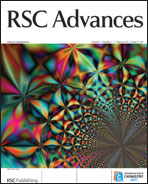A cell compatible fluorescent chemosensor for Hg2+ based on a novel rhodamine derivative that works as a molecular keypad lock
Abstract
A novel fluorescent chemosensor based on rhodamine derivative (Rh1) has been designed and synthesized for detection of Hg2+ ions, which exhibits high sensitivity and selectivity over other metal ions in aqueous solution and living cells. Moreover, this “Off–On”-type fluorescent sensor could successfully mimic a molecular level keypad lock in the presence of Cu2+ ions. Stimulated by the two chemical inputs (Hg2+ and Cu2+), Rh1 undergoes transformation of the structure between spirocyclic and ring-opened spirocyclic, which results in the change of fluorescence. Significantly, the outputs of the system depend on not only the proper combination but also on the correct order of the input signals, which is the most important feature of the keypad lock system. Only a specific sequence of inputs, i.e. the correct password, results in strong fluorescence emission at 555 nm which can be used to “open” this molecular keypad lock. Therefore, this molecular keypad lock has the potential for application in security devices, which could be used to authorize a user, to verify authentication of a product, or to initiate a higher process.


 Please wait while we load your content...
Please wait while we load your content...